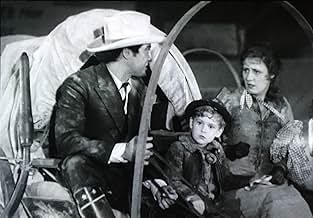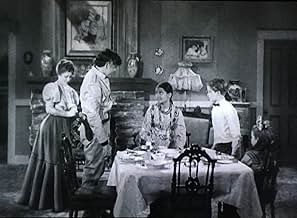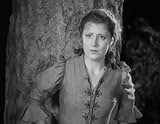IMDb RATING
5.8/10
7.4K
YOUR RATING
A newspaper editor settles in an Oklahoma boom town with his reluctant wife at the end of the nineteenth century.A newspaper editor settles in an Oklahoma boom town with his reluctant wife at the end of the nineteenth century.A newspaper editor settles in an Oklahoma boom town with his reluctant wife at the end of the nineteenth century.
- Won 3 Oscars
- 7 wins & 5 nominations total
Roscoe Ates
- Jesse Rickey
- (as Rosco Ates)
Judith Barrett
- Donna Cravat
- (as Nancy Dover)
Max Barwyn
- Sabra's Luncheon Greeter
- (uncredited)
Frank Beal
- Louis Venable
- (uncredited)
Tyrone Brereton
- Dabney Venable
- (uncredited)
Dolores Brown
- Adult Ruby Big Elk
- (uncredited)
Featured reviews
In fairness to Richard Dix's overacting, Charles Bickford, one of the great character actors ever, also overacted atrociously in "Anna Christie," which was made exactly one year earlier than "Cimarron." The majority of movies didn't go from being silent to talking until 1929 and "Cimarron" was filmed in 1930, so both these films were real early talking films and the performers had not learned to down scale their performances.
The editing and cinematography were outstanding, even revolutionary for that era. The film needs to be viewed in a historic context and not compared to current films. I do agree that "Cimarron" does not hold up as well during the march of time from 1930 to 2008 as does "Public Enemy," "Little Caesar," "Scarface" but it was a complex and ambitious film adaptation of a novel by an outstanding writer, Edna Ferber.
Richard Dix's character does stand up for and vehemently support fairness to Indians and prostitutes, which was a revolutionary idea for a movie made in 1930.
I did notice that Eugene Jackson, the young black teenager, worked for 60 years in the film business, including a recurring role in "Stanford and Son," and in "Julia." Richard Dix, a major star in silent films starting in the early 1920s, peaked around the time of "Cimarron" and by the second half of the 1930s was stuck in B films but did continue his career and stared in films until his retirement in 1947.
Irene Dunne went on to super stardom for the next 20 years and made quite a few classics (check out her film list in her biography.) It is amazing!
I want to compliment the other writers who are classic film lovers but do want to state that too many readers check the not helpful box instead of the helpful box when evaluating the reviews of others. I feel that they are being too picky. After all, we are a select group of people who appreciate old films and should have support each other more as a group, unless the review is vindictive or totally uninformed.
The editing and cinematography were outstanding, even revolutionary for that era. The film needs to be viewed in a historic context and not compared to current films. I do agree that "Cimarron" does not hold up as well during the march of time from 1930 to 2008 as does "Public Enemy," "Little Caesar," "Scarface" but it was a complex and ambitious film adaptation of a novel by an outstanding writer, Edna Ferber.
Richard Dix's character does stand up for and vehemently support fairness to Indians and prostitutes, which was a revolutionary idea for a movie made in 1930.
I did notice that Eugene Jackson, the young black teenager, worked for 60 years in the film business, including a recurring role in "Stanford and Son," and in "Julia." Richard Dix, a major star in silent films starting in the early 1920s, peaked around the time of "Cimarron" and by the second half of the 1930s was stuck in B films but did continue his career and stared in films until his retirement in 1947.
Irene Dunne went on to super stardom for the next 20 years and made quite a few classics (check out her film list in her biography.) It is amazing!
I want to compliment the other writers who are classic film lovers but do want to state that too many readers check the not helpful box instead of the helpful box when evaluating the reviews of others. I feel that they are being too picky. After all, we are a select group of people who appreciate old films and should have support each other more as a group, unless the review is vindictive or totally uninformed.
The outstanding but admittedly dated "Cimarron" dazzled audiences so much that it was a runaway Best Picture Oscar winner in 1931. The film is novelist Edna Ferber's epic tale of the early American settlements of Oklahoma from 1889 and goes to the economic unrest of the Stock Market crash of 1929. Richard Dix (Oscar-nominated) immediately moves his family out to the untamed land and starts a new life. Wife Irene Dunne (Oscar-nominated) has doubts not only about the new land, but also about her husband's adventurous nature. Dix is an individualist with itchy feet and thus he comes and goes as he pleases, but always seems to come through for his family and his adopted state when the chips are down. "Cimarron" is an abbreviated history of a land which was once wild and untamed that slowly became modern by the early-20th Century. The views upon African-Americans and Native Americans is given much air time here. Ferber's equally riveting "Giant" posed similar questions towards Texas' views of women and Hispanic Americans. She was a truly gifted writer and her novels were both adapted into stunning motion picture experiences. Wesley Ruggles' (Oscar-nominated) direction is a bit prodding and the film does stall a bit due to its length, but overall "Cimarron" is an important American movie that if nothing else created the legitimate Western genre. 4.5 out of 5 stars.
Adventuresome and scholarly Richard Dix (as Yancey Cravat) joins the 1889 Oklahoma land rush, and helps settle the territory, with loyal homesteading wife Irene Dunne (as Sabra). His oratory skills as a lawyer and work as a newspaper editor help Mr. Dix defend the downtrodden through the ensuing decades. Notably, Mr. Dix is supportive of Native American (Indian) rights. Dix also helps independent woman and presumed prostitute Estelle Taylor (as Dixie Lee). After some decades pass, we meet the title character, wild and unruly son Don Dillaway (as Cimarron "Cim" Cravat).
"Cimarron" is mostly recalled as the first western to win an "Academy Award" for best film. Some may think it should be recalled as the first time an award was given to prop up the box office of a flop. But, the red ink was due to RKO spending so much on the film; while not recouping its cost, "Cimarron" was one of the biggest box office hits of 1931. It was also a triple crown "Best Picture" award winner, with prizes from "Photoplay" and "Film Daily" included. Those awards were also the ones bestowed upon "The Covered Wagon" (1923), which was the world's previous western standard.
None of this means "Cimarron" is anything more than a swaggeringly average western, with a lot of production cost. Some of it is so dull, the "ethnic" characters emerge as most perversely entertaining. It's difficult to justify the acting nominations for Dix and Ms. Dunne. Director Wesley Ruggles manages the crowds well and adds a few artful moments, like the clever crucifying positioning of Jewish character George E. Stone (as Sol Levy), after some bullying. Edna May Oliver (as Tracy Wyatt) also makes the most of her role, employing many mannerisms seen later in Carol Burnett.
***** Cimarron (1/26/31) Wesley Ruggles ~ Richard Dix, Irene Dunne, Estelle Taylor, George E. Stone
"Cimarron" is mostly recalled as the first western to win an "Academy Award" for best film. Some may think it should be recalled as the first time an award was given to prop up the box office of a flop. But, the red ink was due to RKO spending so much on the film; while not recouping its cost, "Cimarron" was one of the biggest box office hits of 1931. It was also a triple crown "Best Picture" award winner, with prizes from "Photoplay" and "Film Daily" included. Those awards were also the ones bestowed upon "The Covered Wagon" (1923), which was the world's previous western standard.
None of this means "Cimarron" is anything more than a swaggeringly average western, with a lot of production cost. Some of it is so dull, the "ethnic" characters emerge as most perversely entertaining. It's difficult to justify the acting nominations for Dix and Ms. Dunne. Director Wesley Ruggles manages the crowds well and adds a few artful moments, like the clever crucifying positioning of Jewish character George E. Stone (as Sol Levy), after some bullying. Edna May Oliver (as Tracy Wyatt) also makes the most of her role, employing many mannerisms seen later in Carol Burnett.
***** Cimarron (1/26/31) Wesley Ruggles ~ Richard Dix, Irene Dunne, Estelle Taylor, George E. Stone
This is a very dated western but so much so it makes it interesting to watch in spots. However, it's too long - 131 minutes - and I watched it on a VHS tape in which the sound quality wasn't the best, which helped make it too tough to watch in one sitting. Yet, for its uniqueness and strange-looking characters and strange scenes, it made it worthwhile to stick it through to the end. However, the first half of the film is a lot better than the second half.
This was Irene Dunne's first starring role and, frankly, I didn't recognize her. She was anything but pretty and certainly looked different. Her role was that a steady person who keeps her marriage together but has a major flaws, including a real prejudice against the local Indians. In the end, sees the error of her ways. Richard Dix plays her husband. He overacts and looks cartoonish most of the time. This movie was in the beginning of "talkies" and Dix still looked like he belonged in silent movies. He marries Dunne and quickly leaves to go wandering. He comes home briefly and leaves again....and it's okay. Strange.
The story revolves around the two leads (Yancy and Sabra Cravat") and the their town which grows from nothing into a big city by the late 1920s. Seeing that city grow was interesting.
Included in this movie was the strangest "gospel meeting" I've ever seen. It begins well-intentioned, but becomes so spiritually weak and so secular that it makes a farce out of the whole proceedings. You have to see this to believe it. I just shook my head in amazement about how Hollywood has never had a clue when it came to topics like this.
I got rid of the VHS long ago but, if given the opportunity, now that it is out on DVD, would give it another look. It's almost a curiosity piece.
This was Irene Dunne's first starring role and, frankly, I didn't recognize her. She was anything but pretty and certainly looked different. Her role was that a steady person who keeps her marriage together but has a major flaws, including a real prejudice against the local Indians. In the end, sees the error of her ways. Richard Dix plays her husband. He overacts and looks cartoonish most of the time. This movie was in the beginning of "talkies" and Dix still looked like he belonged in silent movies. He marries Dunne and quickly leaves to go wandering. He comes home briefly and leaves again....and it's okay. Strange.
The story revolves around the two leads (Yancy and Sabra Cravat") and the their town which grows from nothing into a big city by the late 1920s. Seeing that city grow was interesting.
Included in this movie was the strangest "gospel meeting" I've ever seen. It begins well-intentioned, but becomes so spiritually weak and so secular that it makes a farce out of the whole proceedings. You have to see this to believe it. I just shook my head in amazement about how Hollywood has never had a clue when it came to topics like this.
I got rid of the VHS long ago but, if given the opportunity, now that it is out on DVD, would give it another look. It's almost a curiosity piece.
Vilified in modern times as one of the weakest and/or worst Oscar Best Picture winner, and spanked as "very racist and very bad" by one author, "Cimarron" does not deserve such condemnation. It won Best Picture because the script is high concept, the type of overarching, epic story that Hollywood has always rewarded.
Its script tells the fictional tale of adventurer and pioneer Yancey Cravat (Richard Dix) who, along with his wife Sabra (Irene Dunne), takes part in the 1889 land rush into Oklahoma Territory, along with thousands of others. In the film, these pioneers stake a land claim and build a new town, called Osage, out on the prairie.
The plot spans some forty years in the Cravat's lives, filled with dreams, accomplishments, sorrow, and interaction with a variety of characters, from prim and proper Mrs. Wyatt (humorous Edna May Oliver) to town thug Lon Yountis (Stanley Fields). Along the way we encounter: gun toting outlaws; dust; a strange gospel meeting; bullies; buildings and walkways made of wood; more dust; the trial of an "immoral" young woman; politicians; and still more dust.
The plot is structured to give most of the film's runtime to the Cravat's lives during the 19th century. As we move into the 20th century, the plot speeds up; characters age a little too quickly. That is a problem I have with the script. The film's tone starts out enthusiastic and rowdy, and ends stoical and long-suffering.
B&W photography is acceptable. There are lots of wide-angle shots, as we would expect for a story set in the wide-open spaces. Prod design and costumes are elaborate and probably accurate for the era. Casting is acceptable. For a 1920s type film, acting is predictably melodramatic. But with his eyes all bugged-out, Richard Dix seriously overacts, even for that era.
In retrospect, there may have been other films as deserving, or more so, for Best Picture of 1931. But at the time, this big-budget Western was almost certainly a predictable winner. I found the story only mildly interesting. But then I'm a creature of a more modern era. And I think viewers would do well to consider "Cimarron" a valid film, one that now gives us some historical perspective, both on Hollywood cinema and on American history.
Its script tells the fictional tale of adventurer and pioneer Yancey Cravat (Richard Dix) who, along with his wife Sabra (Irene Dunne), takes part in the 1889 land rush into Oklahoma Territory, along with thousands of others. In the film, these pioneers stake a land claim and build a new town, called Osage, out on the prairie.
The plot spans some forty years in the Cravat's lives, filled with dreams, accomplishments, sorrow, and interaction with a variety of characters, from prim and proper Mrs. Wyatt (humorous Edna May Oliver) to town thug Lon Yountis (Stanley Fields). Along the way we encounter: gun toting outlaws; dust; a strange gospel meeting; bullies; buildings and walkways made of wood; more dust; the trial of an "immoral" young woman; politicians; and still more dust.
The plot is structured to give most of the film's runtime to the Cravat's lives during the 19th century. As we move into the 20th century, the plot speeds up; characters age a little too quickly. That is a problem I have with the script. The film's tone starts out enthusiastic and rowdy, and ends stoical and long-suffering.
B&W photography is acceptable. There are lots of wide-angle shots, as we would expect for a story set in the wide-open spaces. Prod design and costumes are elaborate and probably accurate for the era. Casting is acceptable. For a 1920s type film, acting is predictably melodramatic. But with his eyes all bugged-out, Richard Dix seriously overacts, even for that era.
In retrospect, there may have been other films as deserving, or more so, for Best Picture of 1931. But at the time, this big-budget Western was almost certainly a predictable winner. I found the story only mildly interesting. But then I'm a creature of a more modern era. And I think viewers would do well to consider "Cimarron" a valid film, one that now gives us some historical perspective, both on Hollywood cinema and on American history.
Oscars Best Picture Winners, Ranked
Oscars Best Picture Winners, Ranked
See the complete list of Oscars Best Picture winners, ranked by IMDb ratings.
Did you know
- TriviaThe celebrated land rush sequence took a week to film, using 5,000 extras, 28 cameramen, six still photographers, and 27 camera assistants. The scene is so iconic that, three decades later, when MGM remade the film, the camera angles for the land rush sequence remained almost identical to the original.
- GoofsDuring the period of the film set in 1907, Yancey is the Progressive Party's candidate for governor of Oklahoma. The Progressive Party did not form until 1912, and then disbanded after Theodore Roosevelt's unsuccessful third party candidacy that year.
- Quotes
Mrs. Tracy Wyatt: One of my ancestors was a signer of the Declaration of Independence.
Sol Levy: That's all right. A relative of mine, a fellow named Moses, wrote the Ten Commandments.
- ConnectionsEdited into Land of the Open Range (1942)
- How long is Cimarron?Powered by Alexa
Details
Box office
- Budget
- $1,433,000 (estimated)
- Runtime
- 2h 3m(123 min)
- Color
Contribute to this page
Suggest an edit or add missing content























